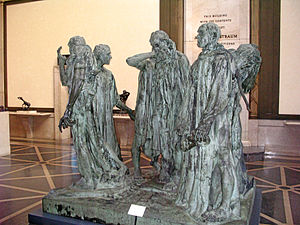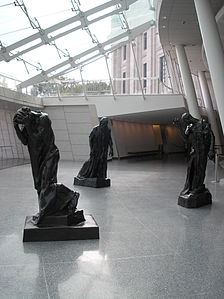Burghers Of Calais
History
In 1346, England's Edward III, after victory in the Battle of Crécy, laid siege to Calais, while Philip VI of France ordered the city to hold out at all costs. Philip failed to lift the siege, and starvation eventually forced the city to parley for surrender.
The contemporary chronicler Jean Froissart (c. 1337 – c. 1405) tells a story of what happened next: Edward offered to spare the people of the city if six of its leaders would surrender themselves to him, presumably to be executed. Edward demanded they walk out wearing nooses around their necks, and carrying the keys to the city and castle. One of the wealthiest of the town leaders, Eustache de Saint Pierre, volunteered first, and five other burghers joined with him. Saint Pierre led this envoy of volunteers to the city gates. It was this moment, and this poignant mix of defeat, heroic self-sacrifice, and willingness to face imminent death which Rodin captured in his sculpture, scaled somewhat larger than life.
According to Froissart's story, the burghers expected to be executed, but their lives were spared by the intervention of England's queen, Philippa of Hainault, who persuaded her husband to exercise mercy by claiming their deaths would be a bad omen for her unborn child.
Composition
The City of Calais had attempted to erect a statue of Eustache de Saint Pierre, eldest of the burghers, since 1845. Two prior artists were prevented from creating the sculpture: David d'Angers by his death, and Auguste Clésinger by the Franco-Prussian War. In 1884 the municipal corporation of the city invited several artists, Rodin amongst them, to submit proposals for the project.
Rodin's design, which included all six figures rather than just de Saint Pierre, was controversial. The public felt that it lacked "overtly heroic antique references" which were considered integral to public sculpture. It was not a pyramidal arrangement and contained no allegorical figures. It was intended to be placed at ground level, rather than on a pedestal. The burghers were not presented in a positive image of glory; instead, they display "pain, anguish and fatalism". To Rodin, this was nevertheless heroic, the heroism of self-sacrifice.
In 1895 the monument was installed in Calais on a large pedestal in front of Parc Richelieu, a public park, contrary to the sculptor's wishes, who wanted contemporary townsfolk to "almost bump into" the figures and feel solidarity with them. Only later was his vision realised, when the sculpture was moved in front of the newly completed town hall of Calais, where it now rests on a much lower base.
Depicted persons
The six burghers depicted are:
- Eustache de Saint Pierre
- Jacques de Wissant
- Pierre de Wissant
- Jean de Fiennes
- Andrieu d'Andres
- Jean d'Aire
Casts

Under French law no more than twelve original casts of works of Rodin may be made.
The 1895 cast of the group of six figures still stands in Calais. Other original casts stand at:
- Glyptoteket in Copenhagen, cast 1903;
- the Musée royal de Mariemont in Morlanwelz, Belgium, cast 1905 (currently on loan to the city of Mons);
- Victoria Tower Gardens adjacent to the Houses of Parliament in London; cast 1908, installed on this site in 1914 and unveiled 19 July 1915;
- the Rodin Museum in Philadelphia, cast 1925 and installed in 1929;
- the gardens of the Musée Rodin in Paris, cast 1926 and given to the museum in 1955;
- Kunstmuseum in Basel, cast 1943 and installed in 1948;
- the Smithsonian Hirshhorn Museum and Sculpture Garden in Washington, DC, cast 1943 and installed in 1966;
- the National Museum of Western Art in Tokyo, cast 1953 and installed in 1959;
- the Norton Simon Museum in Pasadena, California, cast 1968;
- the Metropolitan Museum of Art in New York City, cast 1985 and installed in 1989;
and
- Plateau (formerly called Rodin Gallery and closed since 2016) in Seoul. This is the twelfth and final original cast and was cast in 1995.

Copies of individual statues are:
- sculptures of all individual figures on the campus of Stanford University;
- sculptures of all individual figures (casts from 1984 till 1988) and the First Maquette of the Burghers of Calais, cast 1987, in the Shizuoka Prefectural Museum of Art, Shizuoka City, Japan;
The Burghers of Calais, Rodin Wing, Shizuoka Prefectural Museum of Art - sculptures of Jean d'Aire and Jean de Fiennes as well as busts of d'Aire and Pierre de Wissant on display at the Los Angeles County Museum of Art in the Sculpture Garden;
- a study of Jean d'Aire at Visual Arts Center at Davidson College, cast in 1972;
- "The man with the key" figure (Jean d'Aire), on the Sommerro Park in Oslo, Norway; and
- a bust of Jean d'Aire, recovered a quarter mile away from Ground Zero, together with other pieces from works by Rodin which were in the corporate offices of Cantor Fitzgerald at the original One World Trade Center.
Gallery
-
The London cast of The Burghers of Calais, with the Palace of Westminster in the background
-
Cast in the National Gallery of Australia, Canberra
-
Cast in the Kunstmuseum, Basel
-
Cast in the Rodin Museum, Philadelphia
-
Casts in the garden of the Musée Rodin, Paris
-
Plaque accompanying the Burghers memorial in Victoria Tower Gardens, London
-
Cast in the Musée Rodin, Paris
-
Casts in the Brooklyn Museum, New York City
See also
- List of sculptures by Auguste Rodin
- FRENCH SCULPTURE CENSUS - French sculpture 1500-1960 in North American public collections
Notes
- ^ Linduff, David G. Wilkins, Bernard Schultz, Katheryn M. (1994). Art past, art present (2nd ed.). Englewood Cliffs, N.J.: Prentice Hall. pp. 454. ISBN 0-13-062084-X.
{{cite book}}: CS1 maint: multiple names: authors list (link) - ^ "Burghers of Calais". The National Museum of Western Art. Retrieved 27 January 2012.
- ^ Wagner, John A. (2006b). "Calais, Siege of (1346–1347)". Encyclopedia of the Hundred Years War. Woodbridge, Suffolk: Greenwood. pp. 73–74. ISBN 978-0313327360.
- ^ Froissart, Jean, Chronicles of England France, Spain, and the adjoining countries, (1805 translation by Thomas Jhones), Book I, Chapter 145
- ^ Jiano (1970), pp. 69, 81; Laurent (1989), p. 82
- ^ Jianou (1970), p. 69.
- ^ Elsen (1963), p. 72; Laurent (1989), p. 82.
- ^ Laurent (1989), p. 89.
- ^ "Les Bourgeois de Calais". Archives, Pas-de-Calais. Retrieved 18 November 2020.
- ^ "Original bronze casts". Musée Rodin. Retrieved 6 January 2022.
- ^ "À Mons, une colossale sculpture de Rodin séjournera pendant plusieurs mois". RTBF. Retrieved 18 May 2024.
- ^ Hall, James (2003). "Auguste Rodin, The Burghers of Calais". In Verdi, Richard (ed.). Saved! 100 years of the National Art Collections Fund. Scala. pp. 128–33.
- ^ "The Burghers of Calais". The Metropolitan Museum of Art. Retrieved 29 November 2012.
- ^ "Welcome – Plateau". plateau.or.kr. Archived from the original on 18 October 2018. Retrieved 11 January 2013.
- ^ "With restructuring, a debate rages over Samsung's precious art collection". Hankyoreh. Retrieved 10 October 2018.
- ^ The Burghers of Calais Archived 4 April 2023 at the Wayback Machine, Plateau 2011. Retrieved 11 January 2012.
- ^ "Burghers of Calais, (sculpture)". SIRIS
- ^ 35 works by Rodin, 7 by his contemporaries, given to Stanford, Stanford University News Service (13 July 1992)
- ^ Rodin! The Complete Stanford Collection, Iris & B. Gerald Cantor Center for Visual Arts at Stanford University
- ^ RodinWingGuidebook.pdf (spmoa.shizuoka.shizuoka.jp)
- ^ "Auguste Rodin bio profile". Collections Record Listing. Los Angeles County Museum of Art (LACMA). Retrieved 3 June 2020.
- ^ "Davidson College Art Galleries". Davidson College Art Galleries. Davidson College. 21 March 2012. Retrieved 6 April 2016.
- ^ "Art on the Davidson College Campus". Auguste Rodin – Art on the Davidson College Campus. Davidson College Library. Retrieved 6 April 2007.
- ^ "park, skulptur, Mannen med nøklene". oslobilder.no.
- ^ Barry, Dan; Rashbaum, William K. (20 May 2002). "Born of Hell, Lost After Inferno; Rodin Work From Trade Center Survived, and Vanished". The New York Times. New York City. Retrieved 1 December 2017.
References
- Elsen, Albert E. (1963). Rodin. New York: Museum of Modern Art.
- Jianou, Ionel (1970, transl. Kathleen Muston and Geoffrey Skelding). Rodin. Paris: ARTED.
- Laurent, Monique (1988, transl. 1989 by Emily Read). Rodin. New York: Konecky & Konecky. ISBN 1-56852-173-1.
Further reading
- Benedek, Nelly Silagy (2000). Rodin • The Burghers of Calais. New York: The Metropolitan Museum of Art. ISBN 0-87099-948-6.
- Chevillot, Catherine; Marraud, Hélène; Pinet, Hélène; Adamson, John (transl.) (2014). Rodin: The Laboratory of Creation. Dijon: Éditions Faton. ISBN 978-2878442007.
- Le Normand-Romain, Antoinette (2014). Rodin. New York: Abbeville. ISBN 978-0789212078.
External links
 Media related to Les Bourgeois de Calais at Wikimedia Commons
Media related to Les Bourgeois de Calais at Wikimedia Commons- Interactive 3D imagery of The Burghers of Calais
- Link to The Burghers of Calais Archived 26 February 2021 at the Wayback Machine on the official website of the Musée Rodin.
- Rodin: The B. Gerald Cantor Collection, a full text exhibition catalogue from The Metropolitan Museum of Art, which contains material on The Burghers of Calais.
- Link to account of the theft and recovery of The Burghers of Calais during WWII:
Williams College Magazine, Fall 2013.









